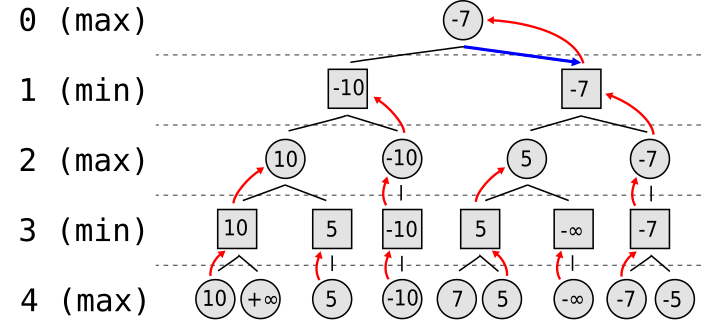This project focuses on computer science concepts such as data structures and algorithms. Chessnut is the chess engine we are using for all the moves and chess logic. We are utilizing a tree to generate the possible chessboards 3 levels deep and depth first search, minimax, and alpha-beta pruning to find the best move based on the following heuristics:
Currently trying to implement multiprocessing as our recursive function uses a lot of computing power so calculating heuristics on board states more than 4 levels deep takes a lot of time. With a depth of 3 leves, our AI makes pretty good moves but also makes a lot of ill-advised ones as well. The AI's chess intelligence is estimated to be at a level 3 out of 9.

These instructions will get you a copy of the project up and running on your local machine for development and testing purposes.
After installing the prerequisites and cloning this repo, go into the repo and create a virtual env:
virtualenv envActivate the env:
source env/bin/activateInstall the dependencies:
pip install -r requirements.txtRun the game with:
python chess_ai.pyIt is HIGHLY recommended that you run chess_ai.py with PyPy to greatly reduce computation time.
Borrowing from Wikipedia's concise definition, the minimax algorithm is "a decision rule used ... for minimizing the possible loss for a worst case (maximum loss) scenario." With respect to chess, the player to act is the maximizer, whose move would be met with an adversarial response from the opponent (minimizer). The minimax algorithm assumes that the opponent is competent and would respond by minimizing the value (determined by some heuristic) of the maximizer.

This simplified tree represents a game where each depth represents a player's turn. Starting at the bottom of the tree (the deeper into the tree, the further into the game), the leaf nodes' values are passed back up to determine the maximizer's current best move. In an actual chess game, the each depth would have many more branches with each branch representing a possible move by a chess piece.
Because of the number of board states possible in chess (estimated to be 10^120), minimax can be improved with a layer of alpha-beta pruning. By keeping track of alpha (the highest value guaranteed to the maximizer) and beta (the lowest value guaranteed to the minimizer), it is possible to avoid calculating the heuristics of certain board states that cannot improve the situation for the current player.

The grayed-out leaf node with a heuristic of 5 is never explored because the maximizer, at that point, is guaranteed a 5 by going left and can do no better than 4 by going right. That is, if the value of the grayed-out leaf node is greater than 4, the minimizer would choose the 4. If it were less than 4, the minimizer would choose it instead. From the maximizer's perspective, there is no reason to investigate that leaf node.
For more information on the history of chess, minimax, and alpha-beta pruning, check out Patrick Winston's lecture.
There are many factors when calculating the heuristics of a chessboard. As we developed our heuristic formula to consider more factors, the computations required to calculate the best move increased exponentially. At the moment, the AI considers the following 4 aspects of a board in its heuristic function.
The material heuristic compares the value of one's pieces with the opponent's pieces. It encourages the AI to capture pieces and make favorable trades. We used the standard values for each piece:
This heuristic calculates the number of legal moves a player can make. It encourages the AI to develop its pieces to exert more control over the board. It prioritizes controlling the center where pieces will have more options to influence the game. For example, a queen near the center of the board can move in 8 directions and thus control more squares, whereas a queen on a corner square can only move in 3 directions.
The pawn structure heuristic gives a score based on the number of pawns supported by other pawns. It encourages the AI to develop its pawns in a way that allows pawns moving forward to be defended by other pawns from behind.
This heuristic checks if a player is in check or checkmate status. It encourages the AI to make moves that would put the opponent in check while avoiding moves that would put itself in check. It also detects if a move would put opponent in checkmate, which would be prioritized over all other heuristics.
The heuristics we used don't come close to representing all the depth involved in chess. Creating a heuristic that would encourage the AI to employ more complex strategies and tactics is not only conceptually difficult. It is also computationally demanding. As we optimize our engine, we would like to tweak our heuristics to better match the complexities of chess.
For more ideas about chess heuristics, check out this article.
This project is licensed under the MIT License - see the LICENSE file for details